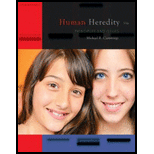
Concept explainers
James sees an online ad for an at-home genetic test that promises to deliver personalized nutritional advice based on an individual’s genetic profile. The company can test for
Once the kits arrive, the family members use cotton swabs to take cell samples from their cheeks and place the swabs in individually labeled envelopes. They mail the envelopes back to the company, along with completed questionnaires regarding their diets. Four weeks later, they receive three individual reports detailing the test results and providing extensive guidelines about what foods they should eat. Among the results is the finding that James has a particular allele in a gene that may make him vulnerable to the presence of free radicals in his cells. The report suggests that he increase his intake of antioxidants, such as vitamins C and E, and highlights a number of foods that are rich in those vitamins. The tests also show that Sally has several genetic variations that indicate that she may be at risk for elevated bone loss. The report recommends that she try to minimize this possibility by increasing her intake of calcium and vitamin D and lists a number of foods she could emphasize in her diet. Finally, the report shows that Patty has a genetic variation that may mean that she has a lowered ability to metabolize saturated fats, putting her at risk for developing heart disease. The report points to ways in which she can lower her intake of saturated fats and lists various types of foods that would be beneficial for her.
A number of companies now offer genetic-testing services, promising to deliver personalized nutritional or other advice based on people’s genetic profiles. Generally, these tests fall into two different categories, with individual companies offering unique combinations of the two. The first type of test detects alleles of known genes that encode proteins that play an established role in, for example, counteracting free radicals in cells or in building up bone. In such cases, it is easy to see why individuals carrying alleles that may encode proteins with lower levels of activity may be more vulnerable to free radicals or more susceptible to bone loss.
A second type of test examines genetic variations that may have no clear biological significance (i.e., they may not occur within a gene or may not have a detectable effect on gene activity) but have been shown to have a statistically significant correlation with a disease or a particular physiological condition. For example, a variation may frequently be detected in individuals with heart disease even though the reason for the correlation between the variation and the disease may be entirely mysterious.
What kinds of regulations, if any, should be in place to ensure that the results of these tests are not abused?
Want to see the full answer?
Check out a sample textbook solution
Chapter 15 Solutions
Human Heredity: Principles and Issues (MindTap Course List)
- Selection of Traits What adaptations do scavengers have for locating and feeding on prey? What adaptations do predators have for capturing and consuming prey?arrow_forwardCompetition Between Species What natural processes limit populations from growing too large? What are some resources organisms can compete over in their natural habitat?arrow_forwardSpecies Interactions Explain how predators, prey and scavengers interact. Explain whether predators and scavengers are necessary or beneficial for an ecosystem.arrow_forward
- magine that you are conducting research on fruit type and seed dispersal. You submitted a paper to a peer-reviewed journal that addresses the factors that impact fruit type and seed dispersal mechanisms in plants of Central America. The editor of the journal communicates that your paper may be published if you make ‘minor revisions’ to the document. Describe two characteristics that you would expect in seeds that are dispersed by the wind. Contrast this with what you would expect for seeds that are gathered, buried or eaten by animals, and explain why they are different. (Editor’s note: Providing this information in your discussion will help readers to consider the significance of the research).arrow_forwardWhat is the difference between Uniporters, Symporters and Antiporters? Which of these are examples of active transport?arrow_forwardWhat are coupled transporters?arrow_forward
- How do histamine and prostaglandins help in the mobilization of leukocytes to an injury site? What are chemotactic factors? How do they affect inflammation process?arrow_forwardCompare and contrast neutrophils and macrophages. Describe two ways they are different and two ways they are similar.arrow_forwardDescribe the effects of three cytokines (not involved in the initial inflammation response). What cells release them?arrow_forward
 Human Heredity: Principles and Issues (MindTap Co...BiologyISBN:9781305251052Author:Michael CummingsPublisher:Cengage Learning
Human Heredity: Principles and Issues (MindTap Co...BiologyISBN:9781305251052Author:Michael CummingsPublisher:Cengage Learning

